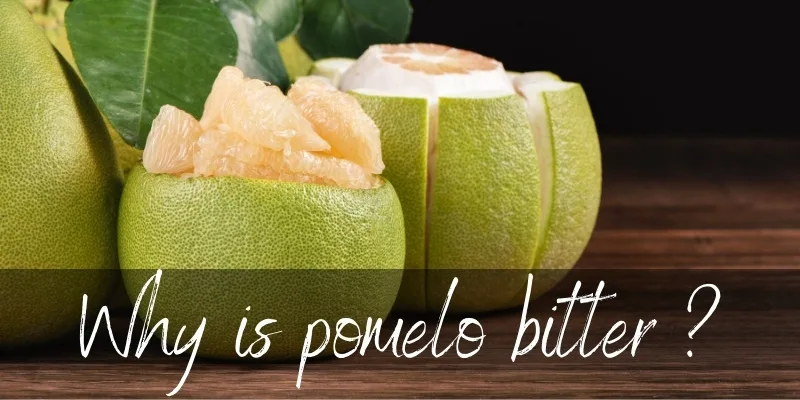If you’re absolutely in love with pomelos, you know they’re not supposed to be bitter. Well, at least the good ones, and the ones you usually find in supermarkets.
But what if you do happen across a bitter pomelo one day, what then ? And is there anything you can do to remove that bitterness ? Well, it turns out there’s an explanation for everything, and yes there is a way to deal with that bitterness.

Why is pomelo bitter ?
Pomelo comes from a line of citrus fruits that contains a very bitter membrane, surrounding the juice vesicules. Pomelos can also turn bitter if they’ve been stored longer than three months at room temperature.
The pomelo is a very hardy, surviving fruit in terms of how well it keeps after harvesting. Because of the thick rind and pith, the pomelo is very well protected from any and all outside elements.
A pomelo that is fresh will taste less sweet and flavorful than one that’s got a chance to sit for a few days or weeks. This is because the fruit needs time to ripen, and develop all of its sugars.
Please note that pomelo is not the sweetest citrus fruit out there. It’s only slightly sweeter than a grapefruit.
Grapefruit inherited a bitter skin from pomelo
As for the membrane or skin in a pomelo, it’s the same membrane that makes grapefruits so bitter. You know that if you peel a grapefruit and get to each segment, it’s covered in a whitish membrane, just like oranges.
Well, if you remove that membrane – kind of a messy job – you remove nearly all of the bitterness. It’s the exact same story with pomelos too. Why ? Well, because pomelos are one of the 4 original citrus fruits, and grapefruits are a cross between pomelo and orange ! Not the sweet orange, the bitter one.
Read also: Pomelo Substitutes
Are some pomelos less bitter ?
Wondering if you can find pomelos that are less bitter to begin with ? Well yes, the lest bitter kind is the one that’s yellowish-white on the inside.
We can’t vouch for the rind color though. There are so many pomelo varieties and each can be green, yellow, greenish yellow, darker yellow, and have varying colors inside from nearly white through yellow, all the way to pink.
But you should look for ones with a light yellow inside. They are usually light yellow on the outside, and don’t look all that interesting, placed next to the other citrus fruits which are so brightly colored.
Of course, you can also find green pomelos with light yellow inside. They’re still ripe, they’re just another variety.
How to get the bitterness out of pomelo
Ah yes, how to get that bitterness out of a pomelo is a good question. We’ll give you a couple of options, and you can choose whichever is best for you.
Remove the skin
The first and most important step is to remove that skin or membrane. Really, that’s the worst offender and the main reason pomelos are bitter most of the time. Just like a grapefruit, no one tells you to peel the membrane until you’ve tastes the bitterness for yourself.
So, here we are, telling you to remove the membrane. It’s much easier than with grapefruit, as it peels very easily and the juice sacs are much firmer, easier to handle, and won’t break apart like oranges or grapefruit.
You will also find some small seeds. While the seeds are harmless if ingested, we don’t recommend eating them. They can be very bitter if you crunch them by mistake. Better to remove them when you see them.
And remember that even a fully peeled pomelo won’t be extra sweet, it will just be like a somewhat sweet grapefruit, but with a lighter flavor.
Read also: Why Is Cucumber Bitter ?
Add a bit of sugar or honey
If you just can’t peel the pomelo, of you’ve already cubed it and don’t want to stop and peel everything, there’s hope. Add honey, sugar, maple syrup, or any other sweetener you like ad eat the fruit like that. It can provide a nice contrast !

You can also add the pomelo to something like a fruit salad, along with other, sweet fruit !
And if your salad is a savory one, then try a honey-mustard dressing, and be sure to add something salty like white cheese or parmesan or prosciutto. It won’t remove the bitterness, but it might hide it well enough. Or, add a few bits of pineapple if you’re feeling adventurous !
How to tell when pomelo is bad
If your pomelo is bitter because it’s starting to go bad, you’ll need a few markers to look for. It might be a bad pomelo, or it might be a good pomelo starting to rot. Here’s how to know your pomelo is going bad:
- very soft pomelo, if it’s starting to wrinkle them it might be going bad
- a bitter taste, even with the membrane peeled
- an alcohol-like smell, the fruit is fermenting (if kept warm)
Pomelos can go bad, but as citrus fruits they keep very well. The best way to keep them is at a relatively low temperature, in the fridge if you can. They can keep for up to three months this way.
They usually come in a protective plastic covering, with a colored mesh overlay. Do not remove them until you’re ready to eat the pomelo, they do a very good job of keeping it safe.
Conclusion
So, pomelo pulp itself should not be bitter, just the membrane of it. If you feel that the pulp is bitter you better check for the rest of the signs to know if it has gone bad.
I hope this article helped you and now you know what to do with pomelo to avoid the bitterness and enjoy it as it should since is a delicious fruit.

